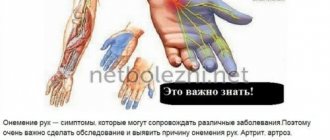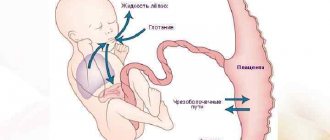Numbness in left leg
A feeling of numbness in the left leg in the absence of other symptoms is a dangerous sign, a possible prerequisite for a stroke or ischemic attack.
Numbness of the fingers, one or more, indicates neuropathy of the tibial and peroneal nerves, the presence of an intervertebral hernia. When dislocated in the area of the fifth vertebra, the hernia can, in addition to numbness, cause tingling, cottoniness and mild pain along the outer part of the lower leg. If the symptoms are supplemented by redness, swelling, or limited mobility of the limb, a cardiological or rheumatological examination is necessary. The femoral part of the left leg goes numb due to degenerative-dystrophic processes associated with pinched nerve fibers.
Numbness in the lower leg indicates damage to the spine, especially if it worsens with physical activity.
Symptoms of rheumatoid arthritis
What causes the legs to become paralyzed? For many, this symptom comes as an unpleasant surprise. People often ask: my leg is numb - what could it be? Sometimes the cause is rheumatoid arthritis. Moreover, the disease itself only deforms the joints, but deformed joints already pinch the nerves, which leads to the symptoms described. In any case, appropriate treatment is required.
When visiting a doctor, it is important to clarify that numbness is occurring. In this case, the necessary medications will be prescribed to help cope with the problem. Because this symptom is only accompanying. It does not always occur, and treatment is prescribed only for the underlying disease.
The influence of bad habits
Bad habits such as drinking alcohol and smoking can lead to numbness in the legs. Moreover, alcohol affects the condition of nerve endings: with severe abuse, alcoholic neuropathy occurs over time. Peripheral nerves are affected, and negative symptoms may not go away at all.
Smoking first affects small vessels, narrowing them, reducing blood flow. However, over time, the habit begins to affect the nerve endings, which also leads to corresponding symptoms. If the situation is under control, then it is enough to give up bad habits to part with unpleasant symptoms. But in advanced cases, drug therapy will be required.
Poisoning with various substances
You can be poisoned by heavy metals, chemical compounds and even medicines and drugs. One of the consequences will be toxic neuropathy. It is characterized by damage to nerve endings and loss of sensation in the limbs. Arsenic, mercury and other industrial poisons lead to the destruction of peripheral nerves. The scale of the problem can only be assessed with a thorough diagnosis in the clinic. Moreover, numbness of the limbs is only one of the symptoms, and not the worst.
What to do if a symptom appears
Most people know why their legs go numb when they sit in an uncomfortable position for too long. They do not have problems if unpleasant sensations appear only in such situations. But sometimes symptoms are observed without objective external causes. Just doing housework, sitting in the office, walking, you can find that:
- legs went numb;
- I can’t feel my feet;
- it seems that the legs have become heavy;
- no sensitivity in fingers;
- legs are swollen, numb, there is a feeling of pain;
- The calf muscle of my left leg goes numb every day.
This is scary and raises many questions, the answers to which are almost impossible to find on your own. On the Internet, users are interested in what helps with numbness in their legs; they are recommended various ointments and folk remedies. But you cannot solve a problem without knowing its true cause. This is how they try to get rid of the symptoms without eliminating the disease itself.
It is possible to understand why your legs quickly go numb when walking or sitting, only after tests. Of course, first you need to take those that can indicate obvious and most common disorders. This way, the specialist will gradually be able to find the cause of the problem.
The harm of self-medication
Today, not only older people, but also young people self-medicate. It has become the norm to purchase various ointments that relieve discomfort. This is due to the fact that this method of therapy is widely advertised. Why get treatment or visit a doctor when, if you feel unwell, you can simply apply a cream or gel that relieves all the symptoms?
The negative consequences of such a decision are associated with the fact that the patient triggers the disease. As a result, doctors have to deal with the problem at a stage when just physical therapy and pills are no longer useful.
Numbness of the leg below the knee
This part of the limb is extremely vulnerable to disorders of the blood vessels and nerve roots. A passive lifestyle and sedentary work can cause pathology. Vascular problems additionally give a burning sensation, loss of sensitivity, cold feet, tingling of the numb area.
Numbness of the right leg is one of the most important signals of sciatic nerve neuropathy, the cause of which is a hernial formation. The symptom intensifies when walking or sitting, and is often accompanied by convulsions.
The same pathologies on the left leg indicate left-sided protrusion of the intervertebral disc. Accompanied by piercing, unexpected pain.
Legs are taken away. When to see a doctor?
There are a number of diseases that can cause loss of legs. The most common are: diabetes mellitus, spinal diseases and vascular lesions.
Diabetes
The most common cause of this phenomenon. This is especially pronounced in patients suffering from type 2 diabetes in the final stages. In type 1, leg withdrawal rarely occurs. A constant increase and decrease in blood sugar levels causes angiopathy, that is, destruction of the walls of blood vessels. As a result, neuropathy – damage to nerve endings – soon begins to progress. Late detection of the disease and insufficient control of the patient’s condition can lead to a severe deterioration in the blood supply to the lower extremities and even provoke their complete failure.
Osteochondrosis
Osteochondrosis is a disease that causes deterioration of the intervertebral discs. Thus, the vertebrae, moving closer to each other, compress the nerves of the lumbosacral region, which are responsible for the functioning of the lower extremities. Due to insufficient innervation, numbness and pain occur. Osteochondrosis affects most adults aged 40 to 50 years. The disease is accompanied by:
- pain in the lower back when bending over;
- stiffness of movements;
- periodic numbness of the legs, accompanied by severe pain.
It is impossible to completely cure osteochondrosis, but massage sessions and medications can significantly alleviate symptoms. Prevention is by maintaining a healthy lifestyle and regular exercise.
rheumatoid arthritis
The symptoms are similar to osteochondrosis. With rheumatoid arthritis, the right or left leg is also amputated, but the cause of acute pain is inflammation of the cartilage tissue, not the bone. The disease can become a complication of a common cold, hypothermia or flu, in which lymphocytes begin to mistake the body's own cells for foreign ones and destroy them. As a result of joint destruction, the lower limbs may completely lose the ability to move. Rheumatoid arthritis requires long-term treatment with hormonal medications and constant medical supervision. Chronic arthritis cannot be cured, so you should not let the disease take its course. The most extreme measure is joint replacement surgery.
Raynaud's syndrome
Raynaud's syndrome is a disease that occurs with spastic damage to the blood vessels of the fingers. This disease is more common in women.
The symptoms are:
- change in skin color of the extremities;
- tingling and burning in the fingers;
- abduction of the left leg in the hip area.
Occurs with systematic hypothermia of the fingers, injuries and vibrations during work in production. It worsens in winter at low temperatures as a result of lack of oxygen and vascular spasm. Taking medications and eliminating factors that cause spasms are ways to relieve pain. An advanced disease and improper treatment can lead to limb dystrophy.
Intervertebral hernia
A hernia in the area of the intervertebral disc also has such an unpleasant symptom as numbness of the limbs, accompanied by fatigue and pain. The pain in the legs is especially severe when staying in one position for a long time. Most often, the disease affects the lumbar vertebrae. This occurs due to compression of the nerve endings. Depending on the location, a hernia can cause pain: in the buttocks, calves and feet. treatment of intervertebral hernia
only possible through surgical removal. Unfortunately, there is a high probability of recurrence. Therefore, after surgery, it is recommended to visit the doctor more often in order to immediately detect the disease.
Atherosclerosis
The most common disease of the cardiovascular system. It occurs as a result of the formation of fatty deposits on the walls of blood vessels, as well as due to age-related changes.
The first signs are usually:
- heaviness in the legs when climbing stairs and running;
- fatigue even when walking normally;
- pain and loss of sensation (later).
Any blood vessels in the body, including the legs, are susceptible to atherosclerosis. The most dangerous damage is to the arteries and veins of the brain, which leads to dementia and other serious diseases. Prevention consists of proper nutrition and the absence of bad habits.
Overvoltage
Normal muscle strain is accompanied by a feeling of heaviness, as well as numbness in both the upper and lower extremities. This condition is very familiar to athletes, as well as older people. You can take a warm bath, get a massage, or undergo physical therapy. These measures will help relieve muscle pain and relieve tension. It is worth paying attention to the intensity of the load and reducing it if necessary.
What to do when your legs are taken away?
First of all, you need to see a doctor. The many causes that cause this problem make it difficult to make a correct diagnosis. For timely detection and prescription of correct treatment, consultation with a therapist, traumatologist, orthopedist and vascular surgeon may be required.
Be sure to undergo a full examination using:
- X-ray therapy of the spine;
- MRI;
- Ultrasound of the brain and spinal cord;
- Ultrasound of the cardiovascular system.
Detection of the disease at an early stage facilitates timely treatment. In some cases, taking appropriate medications will be sufficient. Sometimes constant monitoring by a doctor in a hospital is required. If an intervertebral hernia is detected, surgery will be required. The effectiveness of treatment largely depends on the patient. A healthy lifestyle will help both avoid illness and relieve symptoms.
Prevention measures:
- avoid nervous tension and overwork;
- follow the rules of proper nutrition;
- Get physically active every day.
Author: K.M.N., Academician of the Russian Academy of Medical Sciences M.A. Bobyr
Numbness of the leg on the outside
This pathology has a special medical name - paresthesia, and is of a tumor, infectious, neurodegenerative or autoimmune nature. Accompanied by tingling, burning, and pain of varying intensity.
The sensations can be short-lived or long-lasting, of a paroxysmal nature. The most dangerous are long-term sensory disturbances, the cause of which is the course of chronic pathologies: arthritis, osteochondrosis, diabetes and others. Violations of cellular metabolism lead to persistent disruption of nerve impulse conduction.
Factors influencing the manifestation of symptoms
The nature of pain and the factors causing unpleasant symptoms may vary. For example, if pain occurs due to problems in the spinal region, a person will suffer not only from numbness of the limbs, but also back pain. With multiple sclerosis, coordination and orientation in space are impaired.
A person feels an unpleasant tingling and pain throughout the body. In patients with chronic numbness, unpleasant sensations occur when there is a sudden change in weather, an uncomfortable position, or even stressful shocks.
Complications and consequences of numbness in the legs
The consequences of numbness in the legs are very diverse, leading to a wide range of complications. They depend on the cause that led to the malaise. The main thing that the patient needs to understand is that the presence of frequent numbness is not the norm, this is a very dangerous symptom that requires immediate consultation with a doctor. Timely examination will help protect against serious consequences.
Complications preceded by numbness of the legs:
- loss of tissue sensitivity, partial or complete;
- loss of limb mobility;
- dysfunction of the pelvic organs;
- leg deformity;
- gangrene;
- necrotization of intervertebral hernia.
Why do my hands go numb?
If your arms and legs go numb on one side, then most likely the cause is a stroke, transient ischemic attack, brain tumor or multiple sclerosis.
With a stroke, there are other symptoms: facial asymmetry, speech impairment, numbness of the limbs, muscle weakness. If you experience any of the above symptoms, you should immediately call an ambulance.
In a transient ischemic attack (TIA), a blood clot blocks a blood vessel in the brain for several minutes. This happens if the lumen is too narrow due to cholesterol plaques (atherosclerosis). Attacks occur regularly and are manifested by numbness of the arm, leg and/or face (mainly on one side), weakness, dizziness, double vision, and slow speech. The symptom complex depends on which vessel is affected.
Statistically, a third of people with a TIA will have a stroke, so such patients should definitely see a doctor to reduce their risks.
With multiple sclerosis, numbness of the face, limbs, and individual parts of the body is often the first symptom. Numbness can vary in strength, but sometimes it makes it significantly difficult to move an arm, leg, etc. There are no medications that can help cope with this condition. Despite the fact that the symptom may go away on its own, you should definitely seek help from a specialist as soon as possible.
Diagnostics
The initial doctor’s appointment will consist of listening to the patient’s complaints and conducting an examination, on the basis of which the specialist will plan further diagnostic measures. To make a reliable diagnosis and begin treatment, you need:
- laboratory tests that determine a general, biochemical blood test with calculation of glucose levels, lipoproteins, triglycerides and cholesterol. If arthritis is suspected, a urine test is necessary;
- radiography is an accessible study that excludes injuries, inflammation, the formation of tumors, and bone growths;
- CT, MRI. Highly informative techniques that provide a complete picture of the size, location and nature of the pathology;
- electrophysiological diagnostic procedures that clarify the characteristics of nerve damage;
- Ultrasound, sonography, duplex scanning. Studies shown in the study of arterial lesions, varicose veins. An assessment of blood flow and its character is given. The sizes of the vessels are measured.
Treatment of pathology
Based on the diagnostics performed, the cause of the numbness is identified. The specialist leading the treatment will draw up a course of therapy using medicinal or non-medicinal methods. The full course may include:
- Taking medications. NSAIDs and steroids effectively eliminate numbness. Complex drug therapy uses painkillers, chondroprotectors, muscle relaxants, vitamin-mineral complexes, drugs that activate blood circulation;
- Ointments, gels, creams. The affected area is rubbed with elements of massage, and then medicinal compositions are applied. The products are used once, less often twice a day;
- Diet. The diet is enriched with foods containing B vitamins.
- Physiotherapy. Methods are used that activate blood circulation, metabolic and regenerative processes in tissues. Currents, magnetic therapy, ultrasound and low-intensity laser radiation are widely used.
- Traditional methods. Used only with the permission of the attending physician. Wraps with honey and camphor alcohol, rubbing, baths based on medicinal decoctions are shown;
- Exercise therapy. A set of exercises is selected individually by a physiotherapy specialist, taking into account concomitant diseases, age and current condition of the patient. Classes must be carried out daily, preferably 2 times for 40-50 minutes;
- Surgical intervention. Manipulations are performed according to the identified diagnosis. Traumatic injuries, neuropathy, damage to the nervous system, and vascular anomalies are promptly corrected.








